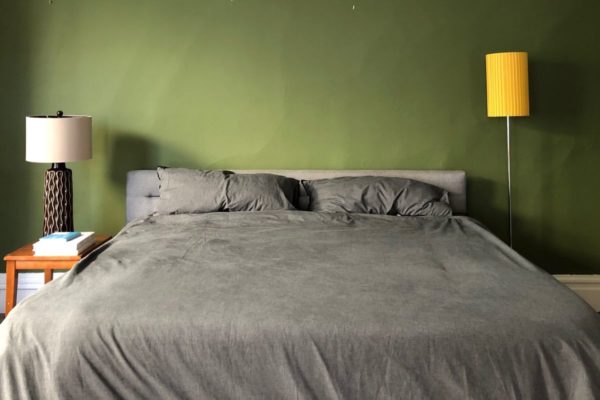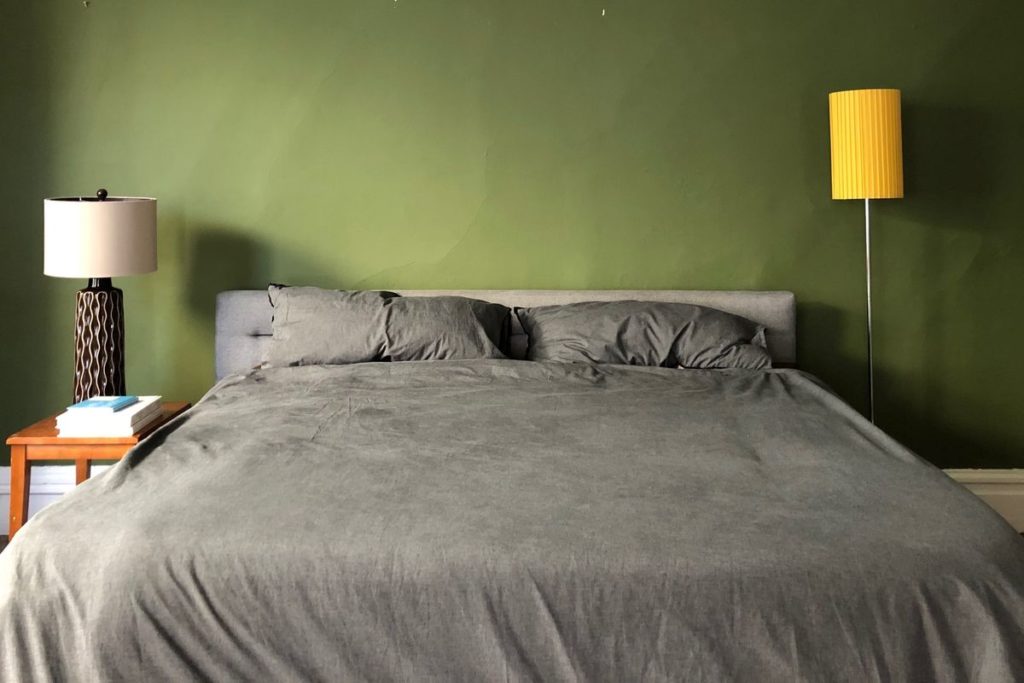
I can’t sleep. Actually, that’s not true. My slumbers of late have improved, but my history with sleep has been a tossy-turny one. While I have learned to accept the volume of thoughts that party in my head during the day, at night they seem louder and have continuously deprived me of sleep. I’m not alone in my sleeplessness; the National Sleep Foundation says that sleep is not only a crucial indicator of our health and well-being, but that the average adult should get seven to nine hours each night. At least 35 percent of American adults log less than seven hours each night.
Last year, I realized my bedroom wasn’t helping things. With three personal communication devices (a laptop, a phone, and a tablet), a squirrelly cat, a television that continues to flicker well after my eyelids collapse, stacks of old books, and a dizzying amount of doodads and bric-a-brac, I had a bedroom better suited for a stimulating afternoon than a good night’s rest, one-and-a-half Lunesta tablets be damned.
While some tips on setting up a room for better getting a good night’s sleep (blackout curtains are a must) helped me temporarily, others, like the oppressive weighted blanket, never did the trick. The idea of removing—not adding more—is what finally helped me catch more rapturous REM.
My idea of a minimalist bedroom goes back years before Kondo became a verb. While studying abroad in college, my French professor, an unapologetic U.S.-born francophile who loathed anything American, espoused the idea that French bedrooms were better because they were strictly for sleep. “They’re not places for hoarding and collecting things like so many bedrooms back home,” she’d sneer.
Although I found ample evidence to the contrary to her sweeping generalization, the idea always stuck with me: Maybe a sleep-only bedroom, one deprived of anything not strictly rest-related, was the way to go?
It wasn’t until I purged my bedroom of almost everything that I understood what she’d been trying to tell me: The true purpose of a bedroom is to facilitate a healthy amount of shut-eye.
I started this process last year when I began living by myself. Here’s how I did it.
Move all but your current reading materials out. My first step was to get rid of the books I had already read—off to used bookstores or free libraries they went, finally liberated to provide literary bliss to others.
If you can, find another home for your clothes. My clothes were divided between a wardrobe in the living room and the hall closet, where I had also stuffed an old dresser.
Ditch the tchotchkes—and even your art. Anything hanging on the walls of my bedroom was banished to the living room, kitchen, bathroom, or hallway.
Get rid of your television. This will be hard for many, but it’s too easy to fall asleep with it on. If I really want to watch something in bed, I can view on one of my three other screens.
Try a sleep-friendly paint color. A new dark-green paint job cocooned the room, more absorbent of snooze-preventing light beams than lighter or brighter colors.

Leave some creature comforts. A few essentials were granted reprieve in my bedroom: a small nightstand with a lamp (overheard lighting belongs in the kitchen and bathroom), a low table for the bay window, two small potted plants, and, of course, my California king-sized bed.
Banish your devices. I moved my phone, laptop, and tablet outside the bedroom, but the first few nights were difficult. I couldn’t resist checking my screens for late-night texts or ego-pumping likes on social media—a temptation that resulted in my leaping in and out of bed to locate my tablet and phone, both of which found a new home in the living room.
Enable your new going-to-bed routine. One week later, I had successfully weaned myself off checking my devices after 10 p.m. At the suggestion of a friend, I’d keep a book—Sapiens: A Brief History of Humankind to start—next to my bed, read it, then fall asleep. It worked one night. Then the next too. And so on. (Don’t let my ability to fall asleep after a chapter or less dissuade you from picking up the book—I have to agree with this reviewer, it’s riveting.)
Find the right amount of minimal for you. The temptation to add more to this quiet place has, at times, proven irresistible. I love stuff. When the urge struck, I added a few items that only enhance the mellow vibe of the room rather than increase its energy. A small fern in a ceramic pot dangles from white macrame next to the parlor doors. A new lamp for more light. And what could easily lead to a slip in my minimalist sobriety, a vertical spine bookshelf, displaying a very small and exceptionally tidy stack of books poised to lull me to sleep, hangs out alone near my barren closet.
And sometimes—rarely—my iPad stays for an occasional sleepover.
Not only have I gained the ability to fall asleep faster, when I wake up during the night, which happens a lot, I also fall back asleep with relative ease. And after a month, I was sleeping longer, especially during the weekends. A sense of awe and calm still washes over me waking up in a bedroom with barely anything in it.
This setup isn’t for everyone. People with children, a gadget-happy partner, or simply less square footage might have trouble creating a premium of empty space. But for me, less is what I need to catch an adequate amount of Z’s. I still keep my Lunesta bottle near, but as it collects dust, it’s next on the list of exiles.





